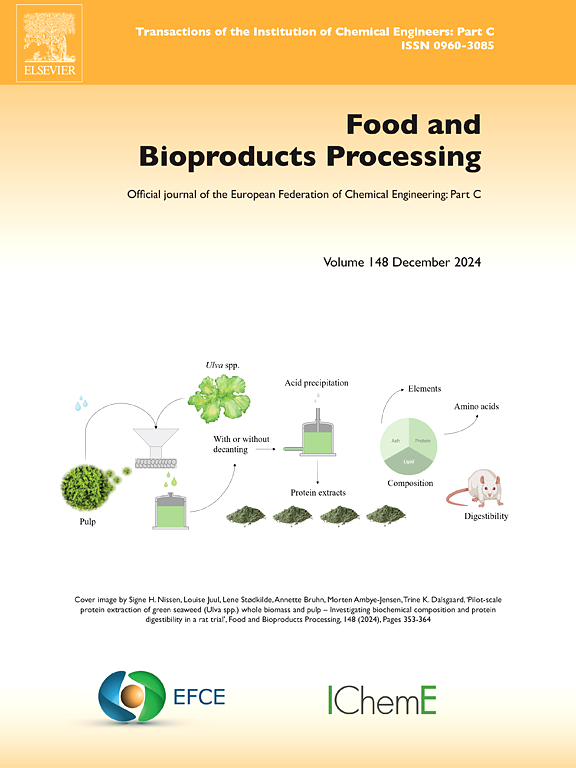乳糖结晶:将机器学习与过程分析技术相结合
IF 3.5
2区 农林科学
Q2 BIOTECHNOLOGY & APPLIED MICROBIOLOGY
引用次数: 0
摘要
乳糖是通过结晶过程从乳清中回收的,在结晶过程中,浓缩的过饱和溶液冷却使乳糖结晶,将杂质留在母液中。设计这一过程需要考虑各种参数,特别是进料溶液的浓度和冷却剖面。为了优化参数,大多数开发人员依赖于试错方法,这对于有经验的人来说是一项可管理的任务,但对于新手来说却是一项挑战。本研究提出了一种利用机器学习(ML)和过程分析技术(PAT)简化乳糖结晶过程开发的新系统,超越了人工试验和错误解释。自动化系统以直接弦长(DCL)反馈控制运行启动,为ML模型提供基础数据,然后在随后的AN1和AN2迭代运行中使用。这些迭代运行具有更平滑的浓度和温度曲线,并且生成更大的晶体,提高了生产率和收率。结果表明,机器学习驱动的方法可以显著优于传统方法,能够精确控制成核和生长阶段,以产生更大的乳糖晶体。本文章由计算机程序翻译,如有差异,请以英文原文为准。
Lactose crystallization: Integrating machine learning with process analytical technologies
Lactose is recovered from whey through crystallization process, where a concentrated supersaturated solution is cooled to crystallize the lactose, leaving the impurities in the mother liquor. Designing this process requires considerations over various parameters, particularly the concentration of the feed solution and the cooling profile. To optimize the parameters, most developers depend on trial-and-error methods, a manageable task for the experienced but challenging for novices. This study presents a novel system that leverages machine learning (ML) and process analytical technologies (PAT) to streamline lactose crystallization process development, going beyond manual trial and error interpretations. The automated system initiated with Direct Chord Length (DCL) feedback control run, which provided the foundational data for the ML model, which was then employed in subsequent AN1 and AN2 iterative runs. These iterative runs have smoother concentration and temperature curves, and it generates larger crystal with enhanced productivity and yield. The results indicate that the ML-driven approach can significantly outperform conventional methods, enabling the precise control of nucleation and growth phases to produce larger lactose crystals.
求助全文
通过发布文献求助,成功后即可免费获取论文全文。
去求助
来源期刊

Food and Bioproducts Processing
工程技术-工程:化工
CiteScore
9.70
自引率
4.30%
发文量
115
审稿时长
24 days
期刊介绍:
Official Journal of the European Federation of Chemical Engineering:
Part C
FBP aims to be the principal international journal for publication of high quality, original papers in the branches of engineering and science dedicated to the safe processing of biological products. It is the only journal to exploit the synergy between biotechnology, bioprocessing and food engineering.
Papers showing how research results can be used in engineering design, and accounts of experimental or theoretical research work bringing new perspectives to established principles, highlighting unsolved problems or indicating directions for future research, are particularly welcome. Contributions that deal with new developments in equipment or processes and that can be given quantitative expression are encouraged. The journal is especially interested in papers that extend the boundaries of food and bioproducts processing.
The journal has a strong emphasis on the interface between engineering and food or bioproducts. Papers that are not likely to be published are those:
• Primarily concerned with food formulation
• That use experimental design techniques to obtain response surfaces but gain little insight from them
• That are empirical and ignore established mechanistic models, e.g., empirical drying curves
• That are primarily concerned about sensory evaluation and colour
• Concern the extraction, encapsulation and/or antioxidant activity of a specific biological material without providing insight that could be applied to a similar but different material,
• Containing only chemical analyses of biological materials.
 求助内容:
求助内容: 应助结果提醒方式:
应助结果提醒方式:


